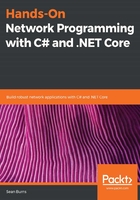
A note on obsolete sub-classes
Here, it's important to note that the WebRequest class is primarily a tool for creating lower-level, protocol agnostic request/response transactions with other resources on your network. The .NET Standard provided sub-classes that, while not explicitly deprecated, have been made mostly obsolete by slightly more robust client classes, such as the HttpClient or WebClient classes.
As a matter of fact, Microsoft recently released a recommendation for always using the newer client classes over any of the slightly older sub-classes that I'm about to discuss. That's precisely why so little of this chapter is dedicated to the concrete classes. The important aspects of the request/response model are still handled by .NET's WebRequest and WebResponse classes under the hood of the new WebClient class. More importantly, those base classes are the most basic building blocks from which you can build your own custom protocol handlers. That's why it's so important to understand, especially for readers new to any sort of web or network programming, how and why the WebRequest class is written the way it is. However, as is often the case with software, times are changing, and so the extent that this lesson will remain useful as a practical guide for specific implementation of common patterns will only diminish with time.
That being said, it is worth examining what is different about those classes and how they can be used to build up a network request from scratch, so let's take a brief look.